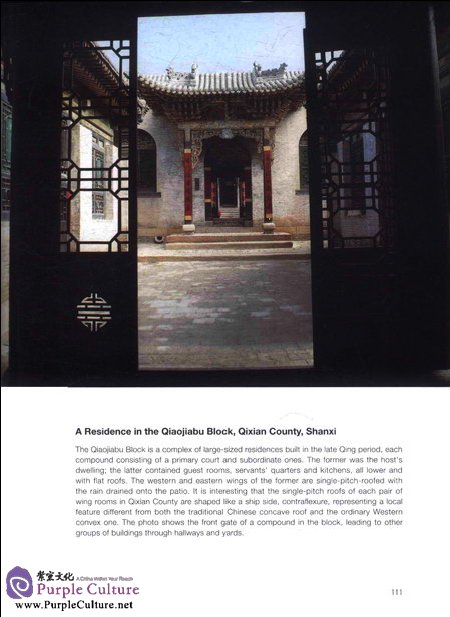The sophistication of ancient Chinese architecture gives it a special place within the architecture of the world. There are magnificent imperial palaces,solemn and breathtaking imperial tombs,mysterious sacrificial and ancestral altars and temples as well as a variety of vernacular dwellings of natural simplicity. Religious buildings are dotted about the country, with a riotous profusion of Buddhist, Taoist and Islamic temples or mosques. On top of all these, city walls and fortifications, civic buildings for miscellaneous purposes are rich in variety and form impressive landmarks. The exceptional series offers wide coverage of themes pertaining to all aspects of Chinese architecture and is unrivaled both for its extensiveness and accuracy as well as for the presentation of the material.
About Author
王其钧,Born in Xuzhou, Jiangsu Province, in 1954, Wang Qijunbegan his professional studies at the Department of FineArts, Nanjing Art College, later obtained his master'sdegree from the Department ofArchitecture, ChongqingCollege ofArchitectural Engineering. He used to be aneditor with the China Architecture & Building Press, buthas, since graduating from Nanjing Art College, alsobeen a painter, many ofhis works for which he has beenawarded a number of prizes been shown at exhibitionsboth on a national and provincial level. A number of hispaintings have appeared in Fine Arts and other journals.His monograph, Chinese Vernacular Dwellings,examines the type, layout, structure, workmanship andaesthetics of these buildings. Drawings in traditionalstyle accompany the text. The author has later onwritten another book on the subject, Chinese TraditionalDomestic Architecture, and recently had a number ofpapers published in the following journals: Architects,Architectural Journal, Fine Arts and Studies on FineA rts, among others.
Map of Vernacular Dwellings
Cave Dwelling Ateas and Surrounding Historic Sites and Scenic Spots
General Introduction
The History of Vernacular Dwellings
-Theif History, Soufce and Development
I. Vernacular DweLlings of the Pre-Qin Period
II. Vernacular DweUings of the Qin, Han and Two Jin Dynasties
III. Vernacular DweUings of the Tang and Song Periods
IV Vernacular Dwenings of the Ming and Qing Periods
Building Forms of Vernaculaf Dwellings
-Residences Implying Public Awareness, the Style Conforming with Local Conditions
I. Classification of Layouts
II. A Combination of Forms
IH. The Layout of Towns and Villages
The Artistic Characteristics of Vernacular Dwellings
-Rusticity Hiding Preeminence, Simplicity Containing Inspiration
I. The Appropriate Employment of Space and Compactness, Emptiness and
Denseness Complementing Each Other
II. A Solid External Appearance and a TranqLul Interior, Artistic Concepts Playing a Primary Role
III. Simple and FLlegant Techniques Employed to Communicate Between Interior and Exterior
IV A Richness of Decoration, Beauty not Characterized by Convention
V The Poetic, Pictorial and Musical F:ssence of Vernacular DweLlings
Notes on the Photographs
North China
Middle Gate of a Residence in Lishi Lane, Dongcheng District, Beijing
Arm-Corridors of a Residence in Lishil.ane, Dongcheng District, Beijing
Screen Wall and Pendant Floral Gate of the Cheng Family Residence in Wenchang Lane, Beijing
The Second Gate of Mei Lanfang's Home, Beijing
Eastern Wing of Mei Lanfang's Home, Beijing
Antecourt of the Kong Family Mansion, Qufu County, Shandong
Hallway of the Kong Fanuly Mansion, Qufu County, Shandong
Tower of Refuge in the Kong Family Mansion, Qufu County, Shandong
Northern Panel of the Screen Door of the Inner Court Gate in the Kong Family Mansion,
A Cave DweLling in Zhangzhao Village, Sanmenxia City, Henan
A Residence in the Qiaojiabu Block, Qixian County, Shanxi
Courtyard No. 1 in the Qiaojiabu Block, Qixian County, Shanxi
Interior Furnishings of the Qiaojiabu Block, Qixian County, Shanxi
A Pendant Floral Gate in the Qiaojiabu Block, Qixian County, Shanxi
A Courtyard in the Qiaojiabu Block, Qixian County, Shanxi
Courtyard No. 2 in the Qiaojiabu Block, Qixian County, Shanxi
Yixiantian Lane in Pingyao County, Shanxi
A Residence in Shajia Alley, Pingyao County, Shanxi
Entrance to a Residence at Shitoupo, Pingyao County, Shanxi
A Cave DweUing at Shitoupo, Pingyao County, Shanxi
Gate of a Residence in Pingyao Count}, Shanxi
Decorat/ons on the Eaves of the Zhu Family Residence in Xucun Village, Huoxian County, Shanxi
Vernacular DweUings in Pingyao County, Shanxi
Dangjia Village in Hancheng County, Shaanxi
A Cave Dwelling in Xihou Village, Pinglu County, Shanxi
Interior of a Cave DweUing in Xihou Village, Pinglu County, Shanxi
The Jiang Family Mansion at Liujiamao, Mizhi County, Shaanxi
Central China
Wood-Carved Ornaments on the Chenggong Flat Brackets and Hanging Pillars in the Fuyuan Hall,
Dongyang County, Zhejiang
Front Gallery of the Main Building in the Fuyuan Hall, Dongyang County, Zhejiang
A Bird's-Eye View of the Fuyuan Hallin Dongyang County, Zhejiang
A Corbie Gable of a Residence in Xidi Village, Yixian County, Anhui
Vernacular DwelLings in Doushan Street, Shexian County, Anhui
Vernacular Dwening in Xidi ViUage, Yixian County, Anhui
A Moon Poolin Hongcun Village, Yixian County, Anhui
Paifang Archways in Tangyue Village, Shexian, Anhui
Vernacular Dwellings in Wangkou Village, Wuyuan Countyjiangxi
The Li Family Residence in Xinli Village, Longnan Countyjiangxi
……
South China
West China
Appendices

